A-5
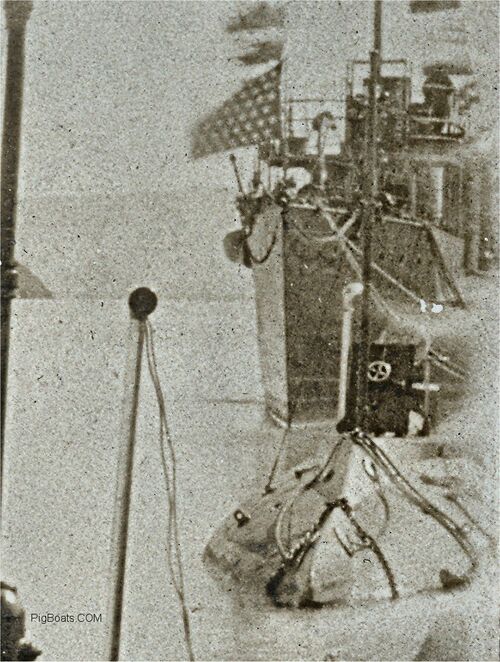
On September 28, 1904 Pike's first commanding officer, LT Arthur MacArthur III, had Pike out conducting experimental torpedo trials in San Pablo Bay. Two torpedoes were fired but failed to surface after they reached the end of their run. One was found later that day by a couple of fishermen but by the end of the trial one was still missing and the incident was reported in the newspapers. The story warned that the missing torpedo was armed with 200 pounds of gun cotton and could be set off by passing ships. A $250.00 reward for its discovery was offered by the Navy. There was no follow-up story about the missing torpedo and it is unknown if it was ever retrieved.
An original NON-Navy photo in the private collection of Ric Hedman.
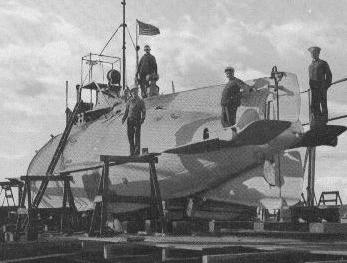
Pike hauled out on a marine railway, location unknown, but likely at the Mare Island Navy Yard, Vallejo, CA., approximately 1905-1906. The man on the far right is standing on one of the stern diving planes.
Photo in the private collection of Ric Hedman.
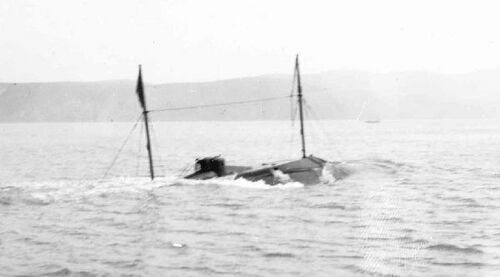
Pike surfacing after a submerged run in the shallow waters of Carquinez Strait, just off Mare Island, CA., circa 1905. The water is just deep enough for her to run just below the surface with a little to spare. This is a safe thing to do in case of an accident.
Photo in the private collection of Ric Hedman.
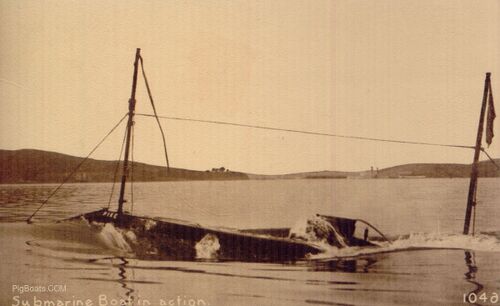
Another photo of Pike taken at about the same time as the one above, about 1905. This was probably a little farther out in San Pablo Bay. The term "pigboats" came in part from the fact that these early boats, in the days before periscopes, had to broach frequently in order for the CO to be able to see where he was going. Old timers thought that this frequent broaching and diving looked a lot like a swimming porpoise, which they referred to as "sea pigs".
Photo in the private collection of Ric Hedman.
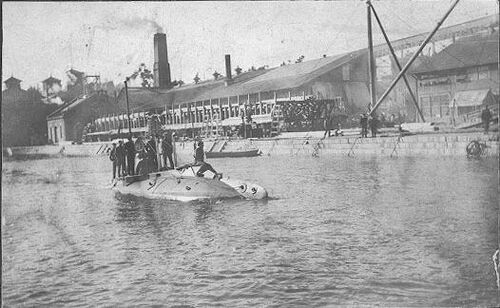
Pike leaving the dock at the Mare Island Navy Yard, approximately 1906. As usual, most of her crew is topside to escape the noise and stifling conditions below. Mare Island was one of two major shipyards on the west coast of the United States, the other being the Puget Sound Navy Yard in Bremerton, Washington.
Photo in the private collection of Ric Hedman.
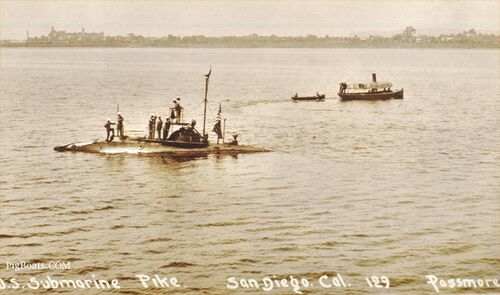
Pike seen here circa 1905 in San Diego Bay on the east side of Coronado Island. The view is looking west out to the Pacific Ocean. On the left background is the Hotel del Coronado. The hotel was built in 1888 and has been a major fixture of San Diego since then and even staring in a number of Hollywood motion pictures. On the photo's right above the motor launch, seen faintly above and beyond the closer shoreline, is a faint headland. This is believed to be Point Loma. The Point Loma Light House can just be seen on the tip of the land.
The sub seems to be just sitting still. It appears a small boat has just departed and is joining a larger steam powered motor launch. It looks like the whole crew is topside. The design compliment was one officer and six enlisted, though the sub may have had a few more than designed.
In 1905 Coronado Island was actually composed of two land masses, North and South Coronado, neither of which was a full island. They were known as “tied islands” as both were connected to the mainland by the narrow Silver Strand beach running to the south to Imperial Beach. North Island (the eventual NAS North Island) was separated from South Island (the city of Coronado) by a small shallow inlet called the Spanish Bight. In addition, NAB Coronado at the south end of Glorietta Bay didn’t exist yet as over 90% of the land associated with it was composed of backfill dredged from the harbor in the early 1940’s. The Bight was filled in 1944 to form the peninsula that we know today.
Photo in the private collection of Ric Hedman.
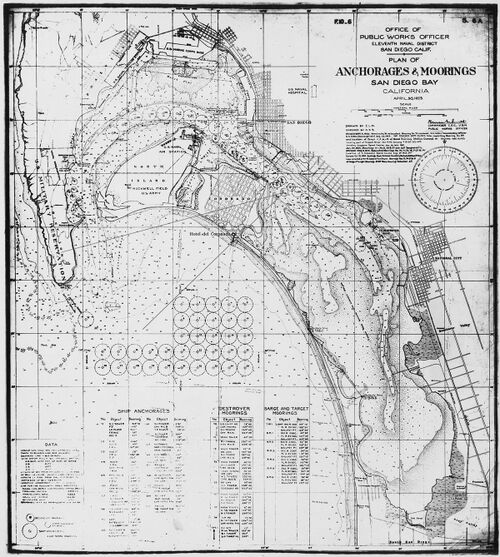
This chart, although drawn up by the 11th Naval District in 1923, will still give a good reference to what is seen in the Pike photo above. Two sight lines have been drawn on the map by Ric Hedman to indicate features seen in the photo above. The photo was taken from approximately the location indicated on the map of anchorage #78, in the main channel between San Diego and Coronado. This chart gives a good visual reference to how the San Diego area was laid out in the early 20th Century. Point Loma was largely barren with only the Army’s Fort Rosecrans at Ballast Point, along with a small Navy fueling depot just to the north of the fort. Naval Air Station North Island was still quite small, taking up only the northern 1/3 of the island, with the Army’s Rockwell Field making up the southern portion. The old Spanish Bight can be clearly seen, dividing North Coronado from South Coronado. Today it is the site of the base golf course. Note also the complete absence of NAB Coronado, just south of Glorietta Bay and Hotel Del Coronado. In later years, San Diego International Airport would be built on backfill over the old Dutch Flat at the north end of San Diego Bay.
NARA Image #295436 in the public domain.
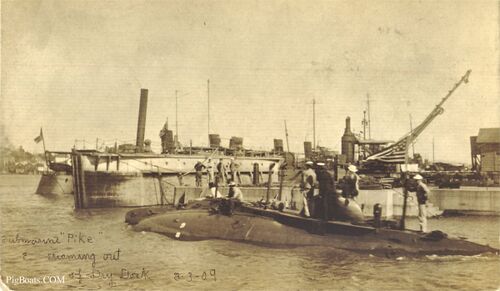
Pike is seen moving out of the drydock at the Mare Island Navy Yard in Vallejo, California on February 3, 1909 after being repaired due to the gasoline fire that damaged her and Grampus. What looks like a wooden sailing ship in the immediate background is actually the drydock caisson, floated out once the dock was full of water and temporarily moored to the side so that the boat could exit. Moored behind the caisson is what looks like a Bainbridge-class destroyer.
USN photo courtesy of Darryl L. Baker.
USS Pike (Submarine No. 6) crew muster for 1910. Data is incomplete due to lost records.
| Donavin, Kirkwood H. - Ensign - age 23 - Born: Ohio |
| Ryan, Raymond - CGM - age 25 - Born: Ireland |
| Essig, William H. - CEM - age 25 - Born: New York |
| *Schroeder, Gustave A. - GM 1c - age 27 - Born: Wisconsin |
| Ertel, Edward G. - MM 1c - age 29 - Born: Germany |
| Bucom, Roy E. - EM 1c - age 24 - Born: Missouri |
| Myrick, Lester B. - EM 1c - age 24 - Born: Maine |
| Ethrington, William J. - MM 1c - age 34 - Born: Michigan |
| Kautcke, Wendel - MM 1c - age 33 - Born: Indiana |
| Murphy, Robert W. - GM 2c - age 32 - Born: Connecticut |
| Ward, Charles A. - MM 2c - age 34 - Born: New York |
*Drowned in F-1 grounding, 1912.
Thank you to Linda Talbott of the US GenWeb Census Project® for providing this information.
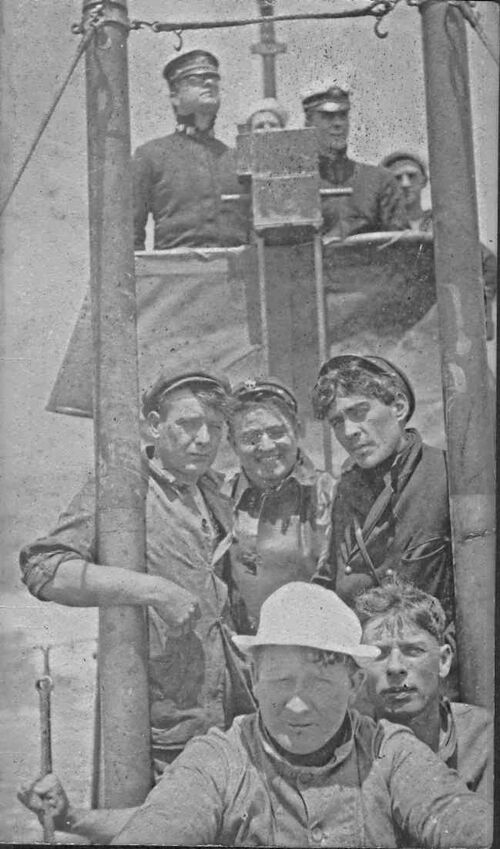
Pike and her crew topside, approximately 1911. The location is unknown but assumed to be near San Francisco. The officer on the right on the bridge is probably the commanding officer, Ensign Kirkwood H. Donavin. One of the three Chief Petty Officers in the center is known to be William H. Essig Chief Electrician's Mate. Which one is not known. A photo identifying him has yet to be found to compare for identification. More on Chief Essig can be found here.
Photo in the private collection of Ric Hedman.

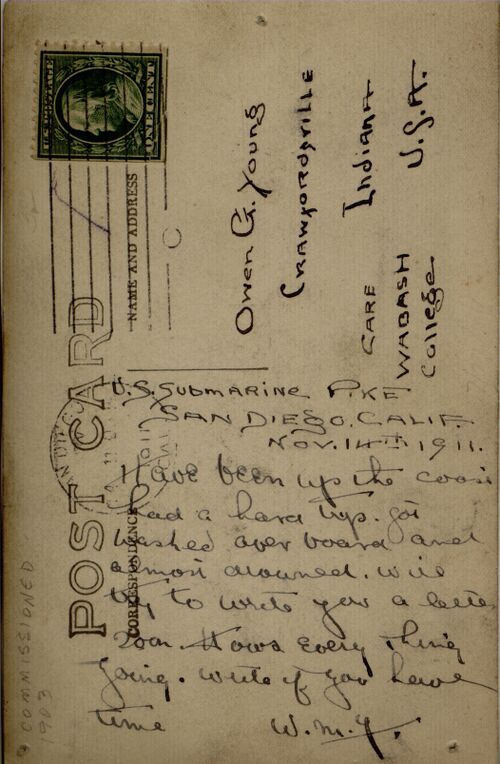
A fine shot of Pike and her crew on San Diego Bay, spring of 1911. This photo was one side of a post card sent home by one of the crewmen. The writing on the back tells the unfortunate story of a sailor who was washed overboard and almost drowned. Unfortunately this sailor's name has been lost to time. The family name (Young) of the sailor who sent the card is not listed in the crew list above, so he likely a friend or maybe relative.
Just three days after this post card was sent, the Secretary of the Navy issued an order that renamed all submarines with a letter/number name. Pike would become the A-5.
Note that the A-class boats were designed for a crew of seven to eight. There are 15 men topside for this photo. See the closeup below for a further explanation.
The back of the card reads as follows:
US Submarine Pike
San Diego, Calif.
Nov. 14, 1911
I have been up the coast
had a hard trip. Got
washed over board and
almost drowned. Will
try and write you a letter
soon. Hows everything
going. Write if you have
time.
W.M.Y (we are fairly sure the last letter in the initials is a "Y")
Photos in the private collection of Ric Hedman.
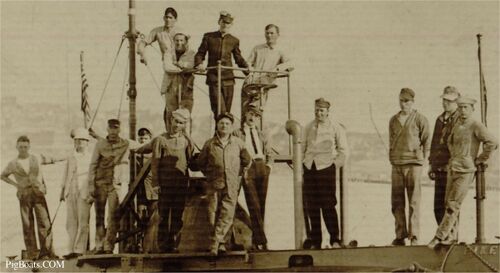
A closeup of the San Diego Bay photo above. Ensign K.H. Donavin can be seen on the bridge in the center. There are 15 men topside, and these boats were billeted for seven to eight men. It was common in those days for boats to send crewmen to other boats on temporary duty, and this likely accounts for several of the extra men.
The two men standing near the ventilator on the forward deck are wearing unusual uniforms, as is the man standing directly under the national flag on the aft deck with the white uniform. It is distinctly possible that these three men are from foreign navies, riding the boat to gain experience for their own services.
The man standing on the forward deck, third from right, very well may be GM 1c Gustave A. Schroeder, indicated in the crew list above. Please see this link to an On Eternal Patrol photo of Schroeder. Unfortunately, Schroeder lost his life in service to his country on October 12, 1912 while serving aboard the F-1 (Submarine No. 20) when she ran aground on the coast of California.
Photo in the private collection of Ric Hedman.

Pike on the Willapa River, at Raymond, Washington, circa 1911-1912. The A-class subs were fitted with a bow fairing to improve sea keeping, this can be seen by the dark shadow area forward of the conning tower. Pike was placed in reserve in 1912 at Bremerton. This photo was probably taken on the trip up the coast to Bremerton. The stern of the USS Chattanooga (Cruiser No. 16) can be seen in front of the sub.
Photo provided by Steve Hubbard of the Pacific County Historical Society, Washington State.
Page created by:
Ric Hedman & David Johnston
1999 - 2023 - PigBoats.COM©
Mountlake Terrace, WA, Norfolk, VA
webmaster at pigboats dot com
